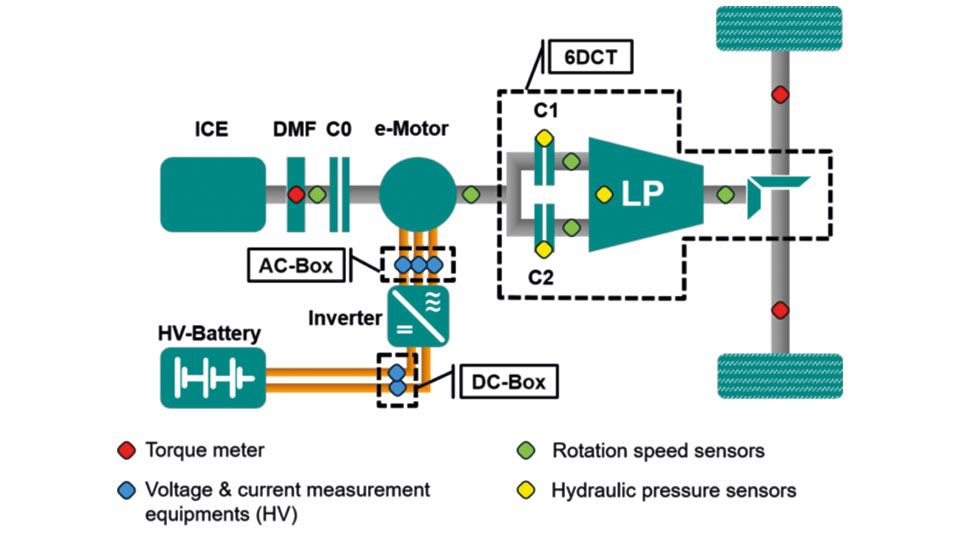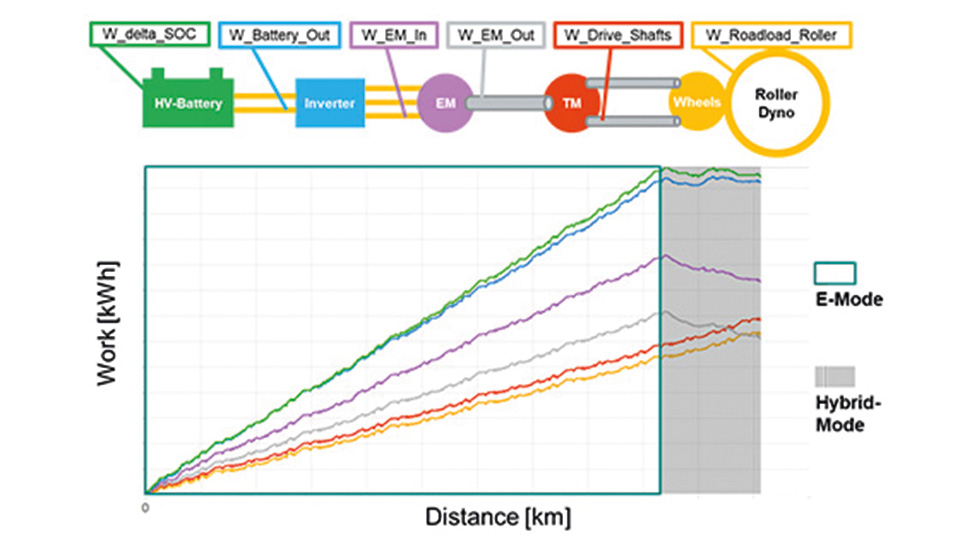Drivetrain benchmarking – the edge in knowledge applied to your development efforts
Today, benchmarking is a common instrument in the industry used to see the bigger picture. The aim is to identify technologies, designs, or processes of competitors in the market at an early stage, to understand them better, and to apply the knowledge gained to one’s own development efforts. This possibility also plays a role in the automotive industry, especially for drives and transmissions in the numerous types of hybrid and electric vehicles. Through drivetrain benchmarking, the automotive industry learns and makes its own development faster, more precise, and more innovative.
As a specialist in drivetrain testing, ATESTEO has the expertise and technology in the company and has long been providing drivetrain benchmarking. Drivetrain testing is a hot topic owing to the dynamics of the markets. The ATESTEO blogging team spoke about the importance of drivetrain testing with Mr Peng He, manager of the Testing Related Engineering division in Alsdorf, Germany.

ATESTEO Blog: Could you please briefly explain to us what is special about drivetrain benchmarking at ATESTEO and what it is all about?
Peng He: The term “benchmarking” is very general. Our benchmarking has to do with the drivetrain. During benchmarking, we examine for our customers the drivetrains of conventional combustion vehicles to battery-powered e-vehicles in terms of driveability, performance, efficiency, and economy. The knowledge gained gives our customers a neutral picture with which they can evaluate where they stand with their development efforts in the market or relative to technology.
ATESTEO Blog: What are the specific benefits of drivetrain benchmarking for automobile manufacturers and transmission developers? And what is the benefit of having ATESTEO do transmission benchmarking for them?
Peng He: There are two main reasons why manufacturers benchmark their own vehicles and those of competitors. First of all, it is about comparisons. Today, it is more important than ever to compare one’s own development with that of the competitor in terms of performance, driveability, shifting behaviour/shift quality, fuel consumption, efficiency, and so on. The reason is that even small refinements can exhibit a large effect. Secondly, it is about the motivation of getting to know the benefits of the vehicles of competitors. When we talk about hybrid vehicles: Which drive strategy does the competitor use in the drivetrain? The concept is important; the technology is developing rapidly. In some cases, we were able to discover new technologies while the customer’s project was still running.
ATESTEO Blog: Could you give us an example, please?
Peng He: We once examined a continuously variable transmission (CVT). We saw a new concept for a mechanical oil pump that uses hydraulic pressure to drive the transmission. It was a new type of vane cell pump that significantly improved transmission efficiency. This product later established itself on the market.
ATESTEO Blog: For which reason do the clients come to you more often: because they want to compare their own drive with that of the competitor’s or because they want to learn more about new technologies?
Peng He: The technology is usually only a side effect – simply because we only see what technology is in the drivetrain of the competitor during a benchmarking process. Normally, our customers are interested in a comparison with a competitor’s product. The customer makes the appropriate specifications for tests to be carried out and we determine the required signals and measurement techniques. The customer’s goal is usually to improve their own new development or to use the findings as a design target or to outperform the competition in the next generation.
ATESTEO Blog: We looked around in the market and searched for competitors in the area of drivetrain benchmarking. We found only a few names. ATESTEO seems to be a specialist in this field. Is that true? What is your value proposition?
Peng He: There aren’t many competitors in this segment. And when there is, the business models are different. It seems to me that our competitors have databases in which they roughly compare and evaluate all vehicles. This stored data is good for selling to customers.
We have a different business model. We apply our expertise and experience from earlier projects and can test different drivetrains – MT (manual transmission), AT (automatic transmission), DCT (dual clutch transmission), CVT (continuously variable transmission) with combustion engines, but also electrified drivetrains such as for HEV (hybrid electric vehicles), PHEV (plug-in hybrid electric vehicles), and BEV (battery electric vehicles).
ATESTEO Blog: What is so special about the services ATESTEO offers?
Peng He: The benefit of benchmarking a drivetrain with ATESTEO is quite clearly the highly customised measurement with the total package. Together with our customer, we create the test specification, and this is where we apply our experience. This results in a customised total package for each drivetrain benchmarking project. One customer just wants to test fuel economy. Another customer wants to put the transmission on the test bench to identify influencing factors such as temperature. Under stable conditions on the test bench, the torque measurements are very, very accurate. This means that for the customer, we can combine vehicle tests with test bench tests. For this purpose, we use our in-house measurement technology, which offers very high accuracy for the transmission input and output. We use the Yokogava measuring instruments for the electrical power because they have the best sampling rate of the voltage and current signals, in our opinion. The measurement technology and good infrastructure of ATESTEO can shorten a project and ensure high-quality execution of the project.
ATESTEO Blog: Can you describe how a benchmarking project at ATESTEO runs? What is tested and examined? It is surely very complex and customers surely want to know what they can expect when they work with you and how long it takes.
Peng He: Well, it usually works like this: We receive an inquiry from a customer. In some cases, the test specification has already been precisely defined. Customers who have already done a lot of testing give us a measurement matrix and tell us which measurements are to be performed. Then the specifications are quickly created. Sometimes customers need support because they do not know exactly what should be measured on the competitor’s vehicle. In these cases, we create the test specification together. In the end, the specifications always depend on the target vehicle and the drive system used. This takes an average of two to three months.
We can procure the vehicle to be examined only when all technical aspects have been determined. ATESTEO can organise all production vehicles and parts around the world. Of course, this sometimes takes a bit of time, but it is manageable.
During the next step, a feasibility study is developed. The customer has defined which signals are to be measured. To measure these signals, we need special measurement technology. To mount this measurement technology in the drivetrain, we have to check the feasibility by disassembling the drivetrain. We have to decide where and how to place the measurement technology in the drivetrain, because after installing the measurement technology, the vehicle has to run normally. We must not allow any external influences. This is the only way we can obtain proper data for the customer.

ATESTEO Blog: That sounds like a lot of detailed planning before benchmarking a drivetrain. What happens next?
Peng He: Yes, that’s exactly right! After the feasibility study, we equip the vehicle with all measurement equipment and the power supply. We have a lot of in-house measurement technology, but we partly also use third-party sensors we have bought. We rely on both. Most of the time, the measurement technology goes in the boot/trunk. This step is called “equipping the vehicle with measurement technology.”
After the measurement technology has been mounted, we start measuring on public roads, on our test track, or on our chassis dynamometer. By the way, our clients can also have the drivetrain removed after each test and connect it to our test bench to find out even more precise efficiency levels. This gives them additional results.
After the test bench phase, we are done measuring. In the next step, we remove the measurement equipment from the vehicle and write a report containing the measurement data for the customer. We can also send tested components of the test vehicle to the customer afterwards. So the customer has the opportunity to analyse the parts again on his or her own.


ATESTEO Blog: Does the customer receive just a volume containing the results? Or do you also analyse the data and interpret the results?
Peng He: Of course, we also analyse the data using our experience. For motor mapping and transmission mapping, we have standardised analyses and evaluations that customers can compare with their own analyses and evaluations.
But basically the analysis and evaluation always depends on the customer and the test specifications. Some would like to measure efficiency, but others prefer measuring the real consumption during a cycle. In general, we offer customers the following: rotational speed, torque via accelerator (gas) pedal, transmission signal, e-motor efficiency, motor signal, hybrid drive systems, driving behaviour on the road and, more specifically, driving behaviour on the test bench (dynamometer).
ATESTEO Blog: Based on the result, there is still a question: Is that the standard that is requested by most of the customers?
Peng He: Yes, it can be said that that is the standard test routine and it leads to the above results. Many of our customers implement this routine themselves in-house. The exact results we get depend, of course, on the type of drivetrain we are testing. If there are electric drive trains, we need the Yokogava measuring system, with which we can measure the current and voltages. For internal combustion engines, we measure with in-house torque sensors. Everything is always completely adapted to the customer’s test specifications.
At the end, the customer receives a complete report, our complete analysis, and the raw data from the measurements. If the customer would like, we also give ratings of the competitor’s vehicle in comparison to the customer’s own vehicle; for example, concerning efficiency, fuel consumption (fuel efficiency), or degree of efficiency.
ATESTEO Blog: Does that mean that at the end, you say which vehicle is better?
Peng He: Yes and no– it depends on the aspects. We create a table with, for example, ten examined performance factors such as driving dynamics, acceleration, drivability, noise, efficiency…. We make a matrix showing a quantitative and qualitative comparison. Our statements are always neutral! You know what can happen: The customer’s engine division says that it is the transmission, and the transmission people say it is the engine. We are in the role of an independent service provider who is commissioned to deliver neutral results. Our evaluation must be very objective so that it is helpful and meaningful in internal customer discussions.
ATESTEO Blog: Do you advise every automobile or transmission manufacturer to conduct drivetrain benchmarking? From your perspective, of course you will now say yes, but our question is really: For which projects is benchmarking truly indispensable?
Peng He: When it comes to new technologies, benchmarking is indispensable. Especially given the backdrop of the goal of reducing CO2, state-of-the-art technology has to be analysed through benchmarking to avoid later penalties. In this case, I would advise every automobile manufacturer to do benchmarking. In particular, when we are talking about electric vehicles, Tesla is the benchmark for the industry. Everyone wishes to quantitatively evaluate the strengths and weaknesses of Tesla. Why is Tesla able to achieve such a large electric range (e-range)? E-range means that the model can drive 500 km with a fully charged battery. It is important to find out: Is it because of the efficiency of the drivetrain? Is it because of the battery? Or it is because of other factors? I want to say that a testing project for an electric powertrain simply brings a lot of benefits. There is already a lot of experience with conventional drivetrains. But electric is a new topic for everyone; everyone wants to improve their own drivetrain in terms of consumption.
ATESTEO Blog: Since you talked about Tesla: Does it happen that even market leaders have their vehicles tested at ATESTEO to see how far their edge in development is?
Peng He: Yes, such cases exist. We have already done projects for customers that actually had a very good vehicle. However, these customers in particular really value benchmarking and wish to have an overview of the market on a regular basis: How good is our own product in comparison to that of the competitor’s or competitors’? What do the others even offer? But that does not mean that a competing product is better and that your own drive has to be changed. Rather, it is a culture of the transmission manufacturer – when it is important, such projects are done on a regular basis. You notice differences in the company cultures.

ATESTEO Blog: How will the drivetrain benchmarking department in your Testing Related Engineering division develop over the coming years? Can you gauge that?
Peng He: We suspect that the topic of e-mobility will become even more important in the future. However, e-mobility also refers to a wide range: from drivetrains with 48 volts to those with 800 volts. And e-mobility does not only mean purely electric. Our future strategy for drivetrain benchmarking is clearly directed towards e-mobility. We have already successfully tested plug-in hybrid vehicles and gathered valuable information. Today, we are able to analyse hybrid vehicles and electric vehicles with very good measurement accuracy. We want to offer even more of this. That is the future of the automotive industry.
ATESTEO Blog: Thank you so much for giving us such a deep dive into the possibilities and procedures of drivetrain benchmarking. It’s a really extensive and exciting topic!

